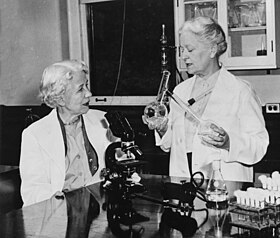Elizabeth Lee Hazen
| Elizabeth Lee Hazen | |
|---|---|

Hazen (left) and Rachel Fuller Brown
|
|
| Born | August 24, 1885 Rich, Mississippi |
| Died | June 24, 1975 (aged 89) Seattle, Washington |
| Residence | New York, New York |
| Citizenship | United States |
| Nationality | American |
| Fields | Microbiology |
| Institutions | New York State Department of Public Health, Division of Laboratories and Research |
| Alma mater |
Mississippi University for Women Columbia University |
| Known for | Developing nystatin, the first anti-fungal drug |
| Notable awards | The Squibb Award in Chemotherapy The Rhoda Benham Award of Medical Mycological Society of the Americas The Chemical Pioneer Award of the American Institute of Chemists National Inventors Hall of Fame |
Elizabeth Lee Hazen (August 24, 1885 in Mississippi – June 24, 1975) is most known for her contribution to the development of nystatin. Her education focused on science and research where she developed a passion for microbiology. Her peers and teachers knew her as a quick learner and a bright student. In 1948, she teamed up with Rachel Fuller Brown to develop nystatin, the first non-toxic drug treatment for fungal infections in humans. Her research had multiple applications ranging from saving infected trees to restoring paintings and artwork damaged due to mold.
Elizabeth Lee Hazen was born on August 24, 1885, in Rich, Mississippi, to William Edgar Hazen and Maggie Harper Hazen. She was their second daughter and middle of three children. Her parents died when she was four, and the three children were adopted by an aunt and uncle.
Hazen attended the Mississippi University for Women (then Mississippi Industrial Institute and College), and obtained a Bachelor of Science degree there in 1910. While teaching biology and high school physics in Jackson, Mississippi, she continued her education by attending summer schools at the University of Tennessee and University of Virginia. Following her teaching job, Hazen applied and was accepted into Department of Biology at Columbia for graduate studies. She completed a Master's of Biology at Columbia University in 1917 and a Ph.D. in microbiology there in 1927, one their first female doctoral students. She served as an Army diagnostic laboratory technician during World War I. In the 1920s, while studying at Columbia University, Hazen worked with ricin and its effect on Clostridium botulinum toxin.
With her strong science background and experience in the field, Hazen continued her research in bacteria and immunology. She was presented with an opportunity in 1931 to work with the New York State Department of Health. She accepted and worked in the Bacterial Diagnosis Laboratory Division in New York City. She had several major accomplishments there in the field of bacterial diagnosis. Among her works there were tracing an outbreak of anthrax, locating sources of tularemia, and tracing the source of food poisoning from improperly preserved foods.
...
Wikipedia
